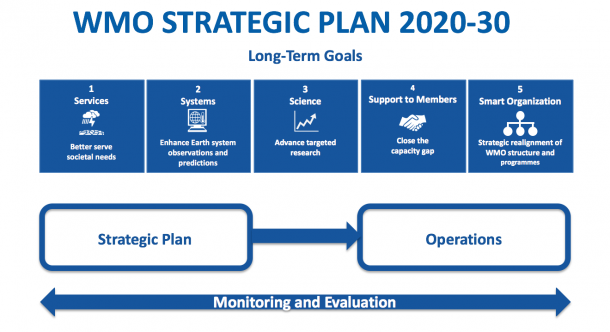Our Mandate
We advance meteorological science for a better future for all.
WMO provides the framework for international cooperation to advance meteorological, climatological, hydrological, and related environmental services, to improve well-being of all. This is why, WMO advocates for an Earth system approach to encompass all the weather-, climate- and water-related cycles traversing the globe, irrespective of national boundaries.

Vision, Mission, Strategic Planning
WMO provides world leadership and expertise in international cooperation in the delivery and use of high-quality, authoritative weather, climate, hydrological and related environmental services by its Members, to improve the well-being of all.
WMO Vision
By 2030, we see a world where all nations, especially the most vulnerable, are more resilient to the socioeconomic consequences of extreme weather, climate, water and other environmental events; and underpin their sustainable development through the best possible services, whether over land, at sea or in the air.
WMO Mission
WMO works to facilitate worldwide cooperation in the design and delivery of meteorological services, foster the rapid exchange of meteorological information, advance the standardization of meteorological data, build cooperation between meteorological and hydrological services, encourage research and training in meteorology, and expand the use of meteorology to benefit other sectors such as aviation, shipping, agriculture and water management.
WMO Strategic Plan 2020–2023 followed by 2024-2027
WMO strategic and operational planning is built on the results-based management concept, established by the Fifteenth World Meteorological Congress as fundamental for managing the planning, budgeting, implementation, monitoring and reporting of programmatic work. The WMO planning process is based on three interlinked components:
- The WMO Strategic Plan 2020-2023 articulates the high-level vision, mission, core values and overarching priorities of the Organization. It outlines a set of long-term goals and strategic objectives with a 2030 horizon as well as identifies areas of focus for the 2020-2023 financial period.
- The WMO Operating Plan 2020-2023 (followed by 2024-2027) translates the strategy into specific actions by defining outputs to be delivered and annual milestones to be achieved. It also lists planned activities, indicates the resources available, and outlines performance indicators intended to measure progress in achieving the strategic objectives.
- The WMO Results-based Budget - maximum expenditure approved by the World Meteorological Congress - identifies resources for implementation of the Strategic Plan, including the functioning of constituent bodies and the Secretariat.
Risk management and quality assurance are embedded in both strategic and operational planning, as well as in monitoring and evaluation processes.
For more information: Strategic planning (community platform)
Operational planning
Implementation of the Strategic Plan is facilitated by the WMO Operating Plan 2020-2023 (followed by 2024-2027), which reflects the results chain towards strategic objectives and long-term goals and provides details on:
- Focus areas/outcomes,
- Performance indicators,
- Outputs,
- Milestones, and
- Activities.
These elements are expected to contribute to achieving the long-term results defined in the WMO Strategic Plan, with the resources provided under the WMO Results-based Budget, and the in-kind support of technical commissions and regional associations.
For each strategic objective, regional aspects and priorities are highlighted based on the WMO Monitoring and Evaluation system, data collected through the Country Profile Database, and information provided by regions. Risks and mitigation measures are also defined for each Strategic Objective.
For more information: Operational planning (community platform)
Monitoring and evaluation
Monitoring and Evaluation are essential components of the WMO Results-Based Management System. They constitute the tools for measuring performance in the timely implementation of the WMO Strategic Plan and Operating Plan. They also contribute to the identification of good practices and lessons learned, which inform the next phase of the strategic planning cycle.
To learn more about how WMO is progressing in implementing its strategic and operating plans, read the latest WMO Performance Assessment Report 2020-2021.
For more information: Monitoring and evaluation (community platform)
Risk Management
The WMO Risk Management Policy builds on the Organization’s Standing Instructions, codes, regulations and rules, together with relevant existing policies, in defining the processes to manage the risks facing the Organization. It is focused on the management of risks associated with the Organization’s activities in order to minimize their negative impacts.
For more information: Risk management (community platform)

